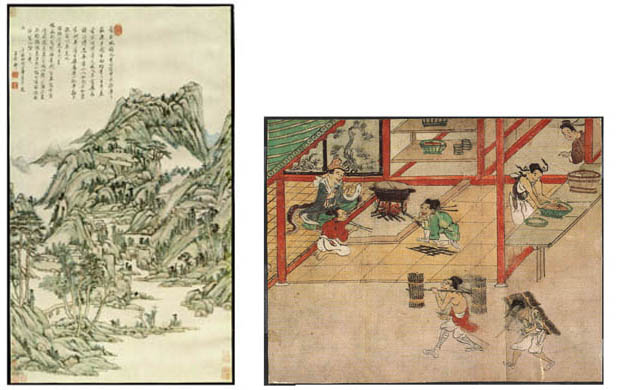
Digital Technology in the Service of Aesthetic Analysis and Theory1
[A paper delivered at the American Society for Aesthetics, Eastern Division, April 2001 and subsequently revised. Apologies if the footnote links do not work. I haven't been able to figure out where the blockage is. The footnotes themselves are at the very end of the text.]
First I want to demonstrate some of the capabilities of digital technology in unraveling the complexities of visual designs, and then to suggest some advances in aesthetic theory that I think this technology may make possible. The first aim will occupy most of the time available to me, and I think that the showing will be reasonably convincing. The second will be pursued much more briefly and in a decidedly tentative and speculative vein. Here I cannot expect my remarks to convince, only to make the possibility of technology assisting theory inviting enough to warrant serious attention being given to it.
Consider a familiar type of Chinese landscape, a early 18th century work done in imitation of the style of a 14th century master, featuring mountains and water (Figure 1) 2. Seen globally and at first sight, the land appears to rise impressively in a long diagonal from the lower left to the massive ridge in the center, an ascent reinforced by the even steeper slope of the mountainside to the right which rises from the surface of the water. The distant peaks in the upper background, their lower reaches lost in mist, clearly speak of high elevations. In contrast, the foreground land-forms, comprising fingers reaching out into the lake, imply substantially lower elevations, not of the plains, to be sure, but of a gentler topography than the mountains in the distance. The two together present a synoptic view of nature as a whole stressing its grandeur.

Above, left. Figure 1. Above, right, Figure 2.
Yet there are unsettling complications in the rendering. The most obvious, universally recognized in Western commentaries on Chinese landscapes in general, is the absence of a single level of viewing. Instead the level of view seems to rise steadily as the land recedes into the distance. This accords with the vertical scroll format, which invites examination from successive levels as the scroll unrolls. It is also related to, and partly represents, a projection scheme with a fully natural basis, which is called (in the West) oblique projection. In this scheme recession perpendicular to the picture plane is represented by parallel rather than convergent orthogonals which usually slant upwards on the picture plane diagonally, as they do quite explicitly in Figure 2.
While strikingly different from ordinary perception, the scheme, called oblique projection, accords exactly with the image produced by light rays proceeding from the scene intersecting the picture plane at a fixed angle (say, 30 degrees). A chief advantage of the scheme is that foreground objects do not block so much of the scene behind them, and distant objects are as legible as near ones. A chief problem with oblique projection is that there is no size gradient for distance – no diminution of things with distance -- so panoramic coverage is impossible if the scheme is rigorously applied.Therefore landscape artists, whose genre traffics in broad scope, can apply it only selectively, combining it with perspective where recession is represented by converging orthogonals. Thus in the present case the land-forms, the herbiage and carpentered objects do diminish with distance, even if somewhat unevenly and, as it were, grudgingly, but finally – and necessarily – radically so as to make room for the distant mountains. 3
This hybrid scheme – obliquity and perspective – has been long recognized as a fundamental of Chinese landscape art.4 Its presence in the case before us is readily recognizable by any clear-sighted observer without benefit of technology. But digital technology enables one to give more detailed, insightful and dramatic demonstrations than the imagination can supply on the basis of mere eye-balling the original. For instance, Figure 3 (below) isolates the foremost land reducing the rest to a faint presence. The eye can then see with great clarity how very low the horizon is for that section. In so doing, it shows that the standard interpretation is not strictly correct, for the individual land-forms are not in strictly oblique projection, with rare local exceptions. The contours that come forward or turn into depth do not tilt down or up in obedience to the tilt of the receding surface of the water, as oblique projection requires.5 They lie relatively flat in obedience to the implied horizon of each successive element. In fact each finger of the land is seen virtually in profile.
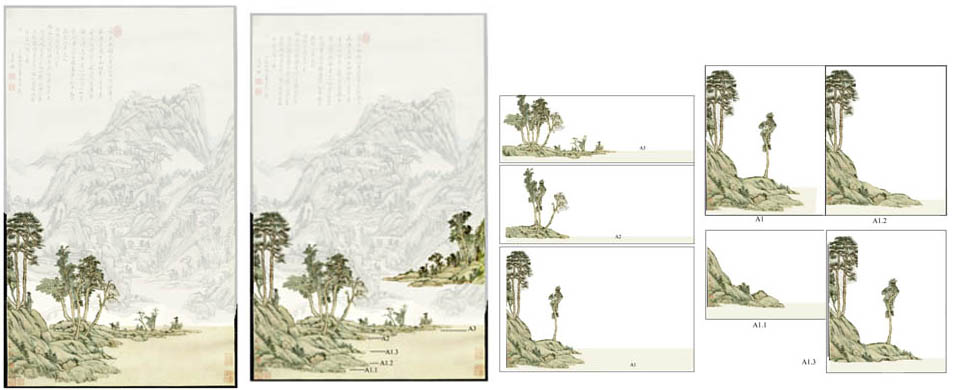
Above from left to right: Figure 3; Figure 4; Figure 5; Figure 6.
Figure 4 adds to Figure 3 a highlighted piece of middle ground on the right. Isolated, that part of the lakeside or riverside floats above the one just in front of it, with its own horizon, quite detached from that of the first. Figures 5 and 6 show how the individual forms comprising the larger sections of the foreground lie flatter in space than is consistent with the implied horizon of the section as a whole. Thus what we have in each section is a fairly dense series of side views (views from a level) which are regularly combined (stacked up, so to speak) to produce an effect of oblique recession.
The remarkable thing about this recession is that when we view it as a whole, we seem to be looking from a fairly high elevation, our eye-level lying about midway up the picture. Seen thus, the open plateau with the house on it seems to slope toward us somewhat downward (not just to the right). We think, how uncomfortable for the occupants! However, we cannot rest with that elevation, as is evident from Figure 7 (below), which isolates the top half of the picture. For when we view this part in isolation, we find ourselves viewing the subject as if from a peak facing the plateau (though in fact no such place is shown). If high enough to account for the tilt of the roof of the house, the viewing level must be high indeed. From that elevation the plateau's forward tilt is very much reduced. If we think of the preceding series of levels as sweeping us along an uptilted ground (in this case mostly water), then with this last rise we seem to have taken flight.
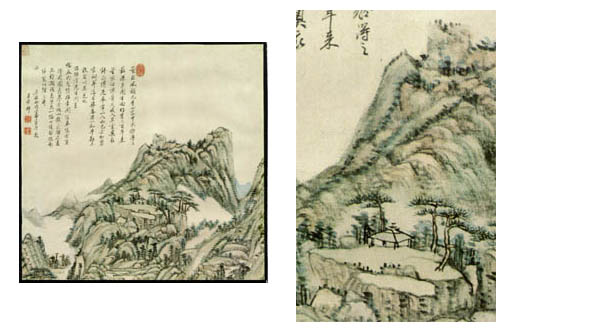
Above, left. Figure 7; right, Figure 8.
Figures 7 and 8 emphasize even more than the original how lofty the mountain must be if the horizon is the one belonging to the foreground, and how very high up the plateau and house must be. But our experience of following the different levels up the picture invites us (ultimately requires us) to take a very different view of the topography. For the water level must be presumed to be virtually the same near and far, since no indication of falling water or rapids is given. Rather the rendering suggests a lake or a slow-moving river. If we spread out that body of water the implication is unmistakable. (Figure 9).

Above, left. Figure 9; right. Figure 10.
The plateau and house, and the massive ridge on which it is set, are by no means so high above the foreground as the scenario suggested by Figures 7 and 8 or even by the picture in unmodified form regarded globally.6 This is, I believe, thematically significant. The implication is that of nature as grand but also somehow mysteriously user-friendly (and therefore significantly different from the implication of the awesome 12th-13th century Northern Sung masterpieces).
The spatial inconsistencies in the work extend beyond those already mentioned. To the left of the central ridge the land dives down into mist to a level substantially below that of the water in the center (Figure 10). In sympathy with this, that same water winds around to the left as if headed for the lowlands, in defiance of the uniform level of still or slowly moving water. The plunging left side of the ridge fits very well the view of the plateau from above since when the viewer focuses on it from there the whole lower section of the picture falls into the periphery, as one can easily appreciate from Figure 11(below). The salience of the left-side plunge is far greater than that of the tangle of elements in the center comprising the upper reaches of the watercourse. In consequence a virtually self-contained scene of near alpine heights is created when our visual spotlight isolates the upper half of the picture.
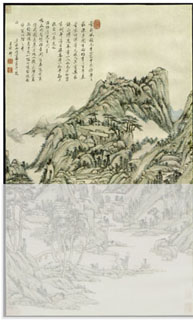
Figure 11.
Now what I believe these exhibits show is how crucial to the effect of the whole is the texture of inconsistencies (or shifts, if that sounds better). What keeps the picture interesting is partly its constant teasing us with perceptual anomalies, which have at least two effects on us. They force our perceptual system to adjust and readjust as our gaze moves about the composition. They pose a challenge to eye and brain. We see from high and low not just everywhere, in the basic plan step by step up the picture plane, but also selectively in abrupt shifts, in some sense absurdities, which nonetheless find a rationale in their relation to a feature somewhere else. And the contradictions (as I prefer to call them) come across not as just artifacts of representation but as part of the content, as indicative of the character of the subject, i.e. as what the picture is ascribing to the natural world. Sometimes it is said that these landscapes invite the viewer to journey through the scenery, which is adjusted so as to look somewhat as it would at the different stages. This scenario might apply to some of the features so far mentioned. But it hardly can explain everything. For one thing it does not cover the global view of the whole or to the view from on high, since there is no indicated place on the itinerary from which those views could be obtained. More importantly it does not explain the virtual detachment of the top part of the scene. Here there seems to be a striving after a more radical theme, one more metaphysical than anecdotal, suggesting perhaps that nature experienced compendiously reveals a mysterious, conceptually baffling vitality (an idea integral to Taoism). I don't purport to speak with authority on this matter, merely to point out that if this is what this sort of Chinese landscape art aims at, subtle spatial anomalies would be a highly suitable instrument. I don't mean that artists conceptualized the machinery. I would suppose that it came to exist in an entirely intuitive way.
II
Now consider a quite different example, a still life by Cezanne of about 1894 (Figure 12) 7 Digitizing the design and modifying it allows one to test what the consequences would be of ironing out its spatial inconsistencies. Careful examination shows that there are (at least) two distinct elevations and two distinct lateral points of view, as well as an equivocal shift of elevation and a plainly false implied horizon. There are also two favorite Cezannian anomalies, first the misalignment of the segments of a single edge, in this case the front edge of the tabletop, and the omission of a segment, here the middle segment of the table edge in the space left by the fall of the cloth. In addition the drawer in the table is flagrantly off-center to the left.
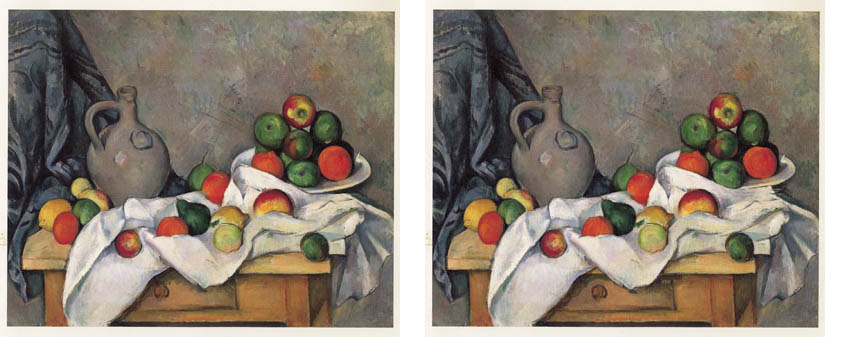
Above, left. Figure 12; right. Figure 13.
The first digitally produced transform (Figure 13) resolves the inconsistency of elevation: the mouth of the jug and the dish of the compote are made to accord with the lower portions to which they belong (for good measure the drawer is centered).
The second (Figure 14) and third (Figure 15) give two options for regularizing the lateral point of view. From studying these options I think we can work out what forces impelled the artist to his solution, given his creative imperatives. The first is to avoid giving too much of the foreground to the table-front. When seen from a single point of view the table-front sprawls out over much too much of the foreground, blocking visual movement around it and making the whole composition bottom-heavy. The worst of these effects attaches to the leftward extension (the gambit a gauche), but the rightward version (gambit a droit) is also pretty clearly unacceptable in this regard. So the bipolar plan of the original presents itself almost as a necessity from that consideration alone.
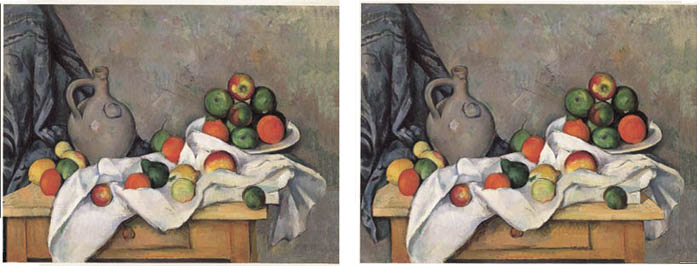
Above, left. Figure 14; right. Figure 15.
So far I have (partly) explained the lateral bipolarity. What of the vertical, the difference of elevation? Unquestionably the jug looks more solid when the neck is straightened up, as Figure13 makes evident. It cannot have been distorted because it was seen to bring the jug more vividly to our consciousness as a rounded object (a claim that is sometimes made), for its undistorted form does that better. A more sensible idea is that the artist wishes to display the arrangement on the tabletop and the compote in a more legible way, as can be done from a higher elevation, while retaining elements of a profile rendering to acknowledge the verticality of the picture plane – the body of the jug and the front face of the table are roughly in frontal projection. But this explanation will not explain all the anomalies of elevation. Figure 16 (below) shows how very low is the horizon implied by the right side of the table. From that level the dish of the compote would be seen from below, as in Figure 16, in flagrant contradiction with even the corrected mouth of the jug in Figure 13 (also such a low horizon would require the jug to be floating well above the table surface). Further, the convergence of the side orthogonals is shockingly abrupt, which is consistent only with an extremely close viewing station, not just a low one. So more is involved than merely two elevations. Rather what comes home to us, I suggest, is a curiously restless mobility of gaze and the probable influence of entirely distinct factors. One factor at work in the low horizon on the right is the need of apparent support for the compote, which more sharply rising and convergent orthogonals, as in Fig. 14, would certainly threaten. Another is arguably the more abstract advantage of decorative consistency – the narrower angles are discordantly singular in the composition.
Similar considerations of formal unity seem to have entered into other choices affecting the inconsistencies of elevation. Why, for instance, must the dish of the compote be so uptilted? Doubtless it would be cheating to cite its consistency with the uptilted mouth of the jug, since the same question arises about that feature. But another formal agreement – likeness of shape – is independent of elevation, namely the likeness to the globular forms of all the other smoothly curvaceous objects on the table. Figure 16 (below) levels the dish at the cost of a certain alienation of it from the rest – the sharper oval seeming out of place – or if you prefer not so harmonious – in the midst of the ampler curves of the others (note especially the handle of the jug).
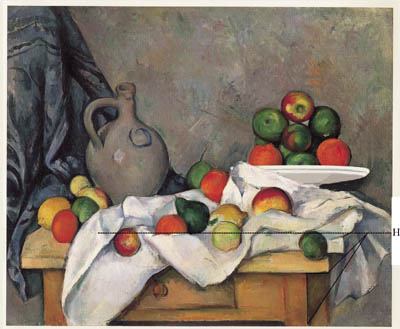
Figure 16. Note the horizon H implied by the receding right side of the table.
Another loss is suffered in linear continuity. The uptilted dish of the original actually uncoils in a spiral that leads on into a serpentine for good measure whereas the leveled dish misses in both respects. In short the artist has integrated the crockery with the winding paths of the fruit and folds of cloth better than is allowed by a perspectivally correct rendering of the same motifs. Given the limited interest of Cezanne's humble motifs, the artist cannot afford to forego any attainable formal felicity. 8 He must infuse his motifs with energy and grandeur by a subtle exactitude of placement – one that also precisely calculates how to keep the general appearance casual, in conformity with the patchy texture and the rough and sometimes straying contours. That such a motivation is habitual is shown by other examples, for instance the dish of fruit shown in Figure 17.
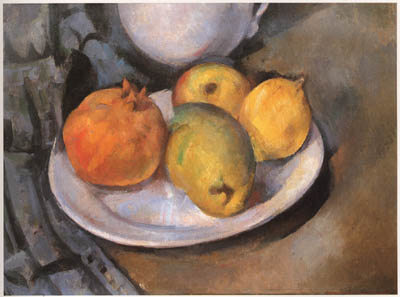
Figure 17
Note that it isn't just the dish whose contours fail to meet. The same is true of the pear, whose large end abruptly vanishes on the one side and carries a cryptic as-if-contour on the other. Cezanne's plebeian objects are filled with an unruly vitality.Yet another principal motivation of inconsistencies of all sorts seems to be the intention to present motifs as rife with inner tensions, as if objects and space itself were being wrenched apart, splayed, or impacted by disruptive forces. Thus in the present example there are the fractured table-top and splayed table, the wrenched neck of the jug and pillar supporting the compote dish, and the curious handle of the jug, which springs out in profile from the neck and twists round to meet the body at a three-quarter angle. Cezanne's objects and even his surfaces are never quiet, never at rest, any more than are his compositions as a whole. Backgrounds are full of floc and flurry with hardly any pictorial pretext (such as shadows or stains). Consider the present case, full of all sorts of dabs, streaks, angularized sections bristling with arbitrary strokes jostling one another. To be sure, perception contains irregularities, but nothing on the scale of Cezanne's backgrounds. Figure 18 shows how a uniform background stifles this bustle.
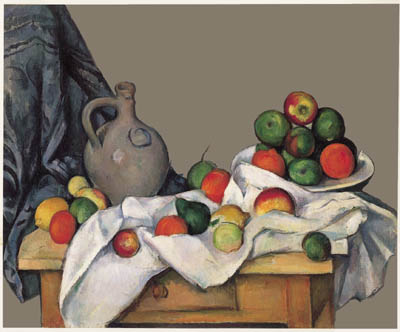
Figure 18.
Also one must grant something to the motive of stressing the picture plane, but not even that will dispose of the phenomenon, since the patchiness is presented as out there, somehow a property of Cezanne's fictive world. In the end the surplus of patchiness can only be accounted for by its evocation of unruly process in the motif, in the world of nature as envisaged by the artist.
You may notice the similarity of findings between the two examples, which are in other ways and in general opinion so remote from each other. In both cases arrant spatial anomalies are essential to the artistic efficacy of the work. One may begin to wonder whether pictorial art can do without inconsistency, and reflect that artful inconsistencies may entrance us by engaging our perceptual powers in extended free play, fulfilling the condition laid down for beauty by one of the greatest philosophers our field can claim. I refer of course to Kant. But time does not permit me to expatiate on that.
III
Now briefly let me draw some lessons from the preceding regarding aesthetic theory, and especially regarding aesthetic theory, and especially regarding aesthetic properties. If we disentangle the concept of aesthetic property from the explicitly valuational or verdictive predicates (beauty, sublimity, exquisiteness and their lesser cousins and negative counterparts) we are left with non-valuational properties which are descriptive though in one way or other not readily decomposable into basic empirical properties of color or geometry or physical substance or utility. Many, perhaps all, are somehow a matter of appearance, like sensory color, but are not easily regimented by tests of intersubjective accuracy. Thus the classic articles by Sibley 9 stress the need for a special sensitivity transcending the merely empirical, taste perhaps (but here his language is biased by his thinking of the verdictive subclass of aesthetic concepts). Others have stressed the role of imagination. Most have agreed with Sibley that our concepts of these properties cannot be rationalized, so to speak, by defining conditions – there are loose necessary conditions but no complete set of necessary and sufficient conditions. Mothersill 10 has gone so far as to maintain that every aesthetic property is utterly individual to a particular object or scene (more exactly to the class of objects or scenes indiscernible from the given one), a view that is on its face both practically and theoretically ruinous. I want to suggest that the peculiarity of aesthetic properties of the descriptive sort, or at least of some large subset of them, can be seen in a much less bizarre light if we attend carefully to the analysis of paintings just presented. We found, I think, that claims about the aesthetic properties of the works, notably the spatial tensions, require to be seen to be fully appreciated, and seen by way of various specific transforms which directly engage our perceptual powers. The higher level aesthetic effects produced by the works (of a mysteriously animated, tempered grandeur in the Chinese landscape, and of a restless field of energy that mysteriously produces rough beauty in the Cezanne still life) emerge from the whole set of lower level features, and can therefore be confirmed only by working one's way patiently and alertly through a large set of transforms. One must go back and forth from the original to the transforms to discover whether one's surmises are borne out or contrariwise rebutted when put to the test. The elusiveness of a given aesthetic property seems likely to be due not to some inherent opacity to analysis, but rather to the limitation of our imagination, a limitation which can be overcome or mitigated by appropriate aids. In short, we can nail a particular claim to an appropriate set of transforms, which have an epistemic effect similar to that of a microscope or stop-action film.
If this is true, then it is not that we have need of a special faculty but rather a fuller set of visually accessible displays. Ordinary vision and imagination will perhaps then suffice to ascertain the given aesthetic property and even fix its degree of intensity, and if so, then perhaps the usual sort of tests of intersubjective validity will apply – those with high powers of discrimination will converge in their judgment, as in sensory properties generally. Those who disagree will turn out to be deficient in the capacity to detect subtle differences.
Note that this suggestion accords, in a fashion, with a classic observation about aesthetic discourse by Arnold Isenberg in 1949 11 , to the effect that aesthetic discourse gets much of its power to communicate from reference to a perceptually present particular example. The procedure I have used plays on this theme by referencing every descriptive claim about the spatiality of the works to a perceptually available exhibit. The idea is that aesthetic concepts gain what specificity they have through the specificity of human response to the set of relevant instantiations, not just to the one that provokes the claim. If we want to discover the conditions that elicit our aesthetic impression we must explore systematically the set of responses to relevant variations, as I have done (or partly done) today. If we make good use of this insight, we may ultimately find out whether aesthetic concepts have properly defining conditions, whether or not they can be made to behave in a conceptually well-ordered way, and if they cannot, to discover the reason why.
Of course my optimism may prove wishful thinking. But at least the recently available technology offers a new path to explore in furtherance of aesthetic theory, above and beyond its service to aesthetic analysis. 12
Appendix
1. Figure 19 shows what the shoreline would have to look like to comply better with an honest point of view of the foreground motif.
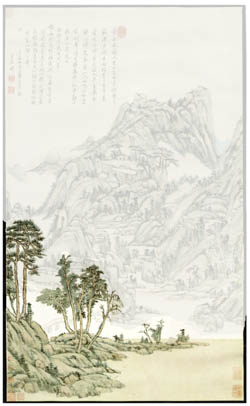
Figure 19.
The near edges of the land forms have been drawn down to match the slope of the water. I have not tried to tilt the far edges up, since that would require sheer invention as well as virtuosity. The result is a modest rise in the implied horizon of the foreground segment. In the original the individual elements are represented virtually in profile fashion, as in an architectural elevation. In such a representation there is no overall horizon, since the orthogonals of an elevation run parallel to each other and so do not converge to any level at all. But a kind of horizon or eye-level for viewing can be placed midway up Figure 19, as the average elevation of the separate parts.
2. Figure 2 reproduces a detail from a Japanese painting featuring (diagonally) oblique projection for the ground and rectangular objects (the building, tables, etc.). Note that the artist has not attempted to present the human figures in the same way. When we isolate them from the context in (on the right side of Figure 20 below) they are plainly seen to be presented from their own level. A sufficient reason for this is the apparent distortion produced for normal viewing by such a projection is too bothersome, but doubtless the virtuosity required is also a potent deterrent. The appended drawing of a coffee cup shows the "distortion" produced by diagonal oblique projection. The image is not distorted in the sense of containing false information. Anyone who knows what the projection scheme is will be truly informed. But it looks distorted to anyone who sees it in terms of perspective or non-diagonal oblique projection or ordinary (head-on) perception (the cup looks exactly right when seen monocularly and obliquely from the right and above, but that is not our normal way of viewing pictures).
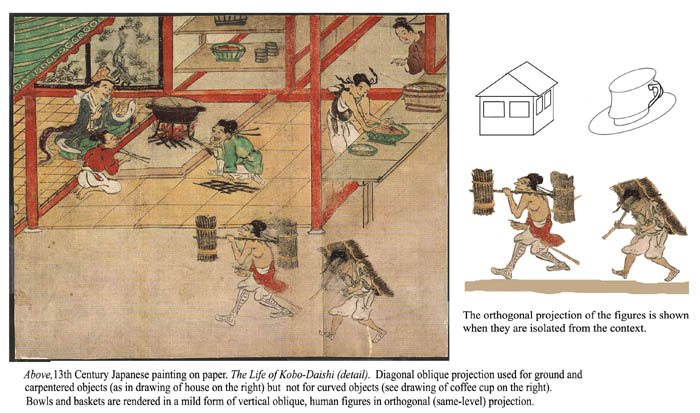
Figure 20.
3. Figure 21 below reduces the size of the house and pine trees on the plateau, to test the effect of better adjusting their size to the indicated distance. Two other transforms suggest themselves (not presented here): one that straightens up the house and or plateau, to limit the height of the highest implied viewing level; one that lifts the extreme left side of the composition at the level of the rise to the plateau in order to even up the water level on both sides of the ridge. The aim of all three would be to test how much the painting would lose of its positive aesthetic qualities by damping down the spatial inconsistencies. Here the original is placed beside Figure 20 for comparison.

Above, left. Figure 20; right,Figure 1 (the original).
4. The high scroll-like format suits oblique projection of the ground because as the viewer's eye moves up (or the scroll passes downward across her eye-level) as the scroll is unrolled, the eye's focus on a given level necessarily relegates the rest to the indistinct periphery. Such works are generally meant to be seen close up, from where the detail of figuration and brushstroke can be appreciated, which sharply limits the area of visual clarity at any given moment. Given that, a favored viewing strategy is to begin at the bottom and proceed upward, which corresponds to beginning with the foreground and proceeding ever deeper into pictorial space. The viewer finds her level at each phase of the process, rather than continuously being visibly referred back to the original ground level or to a global horizon. That initial level and the things on it remain more a memory than a factor in present perception, something one has left behind, largely because oblique projection insures that the later motifs are as legible and self-contained as the ground level. Of course a hybrid scheme like the present one, with a perspectival reduction of individual motifs with distance, somewhat reduces legibility with distance, but the effect of that is simply to enlarge the scope of the self-contained view from higher elevations. Note that when I say "self-contained" I only mean relatively self-contained, that is, in comparison with dominantly perspectival works where the viewer is constantly made aware of the single horizon and converging orthogonals.
5. A question arises of what aesthetic qualities of the painting are highlighted by the Photoshop transforms. I have spoken of its spatiality being contradictory, hyper-naturally revelatory, and mysteriously vital; and of this conferring upon the fictive subject a admixture of almost antithetical qualities, a rugged grandeur conjoined with amiability. I do not clearly see just how these descriptions relate to the paradigmatic aesthetic quality descriptions but I feel confident that this relation can be elucidated. For a start one could speak of the picture being expressive of the mysterious vitality of the natural world. But much more needs to be said (and discovered) about the relation.
6. The Freer catalogue describes the work as "a painstakingly assembled composition of innumerable, carefully designed units," and the artist's approach as "intellectual." Wang was a scholar and official in the Ch'ing (Qing) Dynasty who frequently recast classic works in his own distinctive way. The text on the painting is entirely autobiographical, recounting the circumstances surrounding his painting the work. It sheds no light on the properties of the painting itself.
7. There is much that is relevant to my analysis in the classic discussion of the aesthetics of Chinese painting by George Rowley (Principles of Chinese Painting, Princeton, Princeton University Press, 1947; revised edition 1959) has to say about Chinese treatments of space. Yet his tendency to overstress the difference between Chinese and Western methods and effects in my view obstructs understanding of the details of a work such as the present one. This is not the place to enter into a review of Rowley's interpretations, interesting as they are in their own right, partly because I don't feel in a position to sort out what is true in them and what is not.
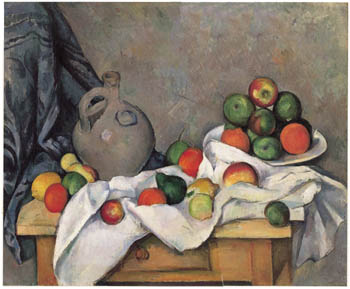
Figure 21
8. Figure 21 exhibits the consequence of angling the body of Cezanne's jug forward to match the tilt of its mouth and the dish of the compote. An effort has also been made to regularize the handle but perhaps with only limited success. The effect of this reconciliation of the body of the jug with the dish of the compote is to sharpen the conflict of the two elevations to a distressing degree. It is better to keep the body consistent with the unseen but implicitly erect base and stem of the compote. Otherwise the stability of the whole composition is seriously impaired.
Footnotes
1. I gratefully acknowledge an Improvement of Instruction grant from the University of Maryland , which made available the resources necessary for the digitizing, transforming and printing of the exhibits included in this paper. The program used was Photoshop 5.5.
2. Landscape in the style of Huang Kung-Wang, by Wang Yuan-Ch'i, 1706. 38 ½ by 23 5/16 inches. Ink and color on paper. Freer Collection 62.5.
3. Not all Chinese landscapes use a generally oblique projection scheme. Many are dominantly perspectival. But practically none are as rigorously perspectival as typical post-Medieval paintings in the West (at least before the late 19 th century).
4. Well, obliquity of the basic ground plan has been. Perspective has been less fully acknowledged, perhaps because it is not understood that a diminishing size gradient is basically perspectival. So far as I am aware, the spatiality of Chinese landscapes has never been systematically elucidated.
5. In oblique projection the frontal plane of a carpentered object is shown in profile but planes extending into depth slant up. Traditional Chinese paintings typically use oblique projection for carpentered objects and for the ground plan, not (so much) for objects with complex curves, such as humans or animals. Were they to do so, these figures would have the “distorted” contours of the shadows cast by light obliquely from below, which is doubtless a reason why they are not so depicted. It is notable that in the present painting the sides of the houses in middle distance do not slant up, as oblique projection would require. Figures 2 and 20 illustrate oblique projection. Figure 19 revises the forward land form in Figure 1 in a more nearly consistent diagonal oblique projection.
6. Other features reinforce the impression of moderate rather than great height/distance. The pines on and near the plateau are taller than is perspectivally consistent. The house itself is also too large by that standard, since it is the same size as those closest to it standing on pilings in the water. The bridge in the lower left is also tilted up as if seen from a high elevation. Several rock forms and the contour of the land facing the bridge also deviate from the norm.
7. Curtain, Jug and Compote , 1893-94, 23 ½ by 28 3/4 in., ex-John J. Whitney Collection. Reproduced in the catalogue of the Cezanne retrospective at the Philadelphia Museum of Art, 1996.
8. As in Figure 22, where the smoothly uncoiling chains of fruit are disturbed. A similar consideration applies to the colors. Figure 23 changes several orange-reds, ruining Cezanne's serpentine chain of that color.



Figure 1 Figure 22 Figure 23
9. Notably “Aesthetic Concepts,” Philosophical Review LXVIII (October 1959), 421-450 and “Aesthetic and Non-Aesthetic,” Philosophical Review LXXIV (1965).
10. Mothersill, Mary, Beauty Restored , 1984.
11. “Critical Communication,” Philosophical Review LVIII (July 1949), 330-344. I do not mean to endorse Isenberg's ruminations about the semantic character or function of aesthetic predicates. Indeed my hope is that these predicates will turn out to be less peculiar and more straightforwardly empirical than he believes possible.
12. I realize full well how limited a demonstration I have given, relative to the enormous diversity of descriptive aesthetic properties, even of those instantiated by paintings. Not all will be easy to approach with the digital technology presently available.